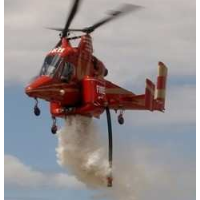Night Aerial Firefighting: 3 Years Late and Still Counting

Three years after the devastating Station Fire in Southern California raised questions about the state’s policy of not fighting fires from the air at night, the U.S. Forest Service has reversed a 30-year policy and will allow helicopters to fly missions over federal land.
But the policy won’t be changed fast enough to help battle wildfires that are racing through California now, tying up 8,000 firefighters and threatening everything from nudist camps to hidden maijuana fields. The new policy of allowing water-carrying helicopters to fly at night is scheduled to take effect next summer and will only apply to blazes on federal lands in Southern California.
It will also be a modest effort. Only one helicopter is being designated for use and will be stationed in the Angeles National Forest. Tom Harbour, Forest Service director of fire and aviation management, said $2 million in initial funding would be provided and the operation would be handled by an independent contractor.
Harbour said if the new policy is successful, more helicopters would be added and that the program might eventually include medical transport for firefighters and other support functions.
The Station Fire damaged 160,000 acres in the Angeles National Forest, destroyed 200 structures and resulted in the death of two Los Angeles County firefighters. Some observers feel that if night flying had been permitted, the fire could have been snuffed out early, perhaps after the first day. Instead, it burned for seven weeks.
The Forest Service has said the night-flight ban was necessary because flying in rugged national forests at night was unsafe and others have questions the cost. Many agencies, including Los Angeles city and county fire departments, use aircraft to dump water on fires at night.
In congressional hearings after the fire, Forest Service Chief Tom Tidwell promised that his agency would study whether using helicopters at night was cost-efficient and safe.
But a year later, no progress had been made and in May 2011 California Senator Dianne Feinstein complained publicly that it was “unacceptable” that the agency hadn’t added more night-flying aircraft and changed its policy. Three studies of the issue that were supposed to be completed at the beginning of that year had not been completed.
In the intervening years since the Station Fire, global warming and budget cuts have added a new threatening dimension to the annual California fire season that is practically year-round now.
Senator Feinstein said in a prepared statement: “This is long overdue but a welcome policy change by the Forest Service. Attacking fires from the air at night can bolster firefighting efforts because temperatures are cooler, humidity is higher and Santa Ana winds die down.”
–Ken Broder
To Learn More:
Feds to Allow Night Aerial Firefighting in S Cal (by Michael R. Blood, Associated Press)
Forest Service Ends Ban on Night Flights to Battle Fires (by Paul Pringle, Los Angeles Times)
Delays on Additions to Forest Service's Firefighting Fleet Unacceptable, Sen. Dianne Feinstein Says (by Catherine Saillant, Los Angeles Times)
- Top Stories
- Controversies
- Where is the Money Going?
- California and the Nation
- Appointments and Resignations
- Unusual News
- Latest News
- California Forbids U.S. Immigration Agents from Pretending to be Police
- California Lawmakers Urged to Strip “Self-Dealing” Tax Board of Its Duties
- Big Oil’s Grip on California
- Santa Cruz Police See Homeland Security Betrayal in Use of Gang Roundup as Cover for Immigration Raid
- Oil Companies Face Deadline to Stop Polluting California Groundwater





